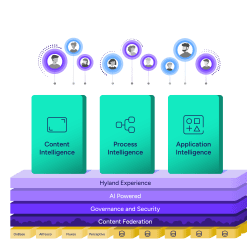
The Content Innovation Cloud
Harness the power of a unified content, process and application intelligence platform to unlock the value of enterprise content.
Learn moreInsert your title here
Insert your title here

Solutions
Explore Hyland’s solutions by industry, department or the service you need.
Overview of solutionsIndustries
It's your unique digital evolution … but you don't have to face it alone. We understand the landscape of your industry and the unique needs of the people you serve.
 Overview of industries
Overview of industries
Departments
Countless teams and departments have transformed the way they work in accounting, HR, legal and more with Hyland solutions.
 Overview of departments
Overview of departments
Services
We are committed to helping you maximize your technology investment so you can best serve your customers.
 Overview of services
Overview of services
Insert your title here

Customers
Discover why Hyland is trusted by thousands of organizations worldwide.
Hear from our customers
Partners
Our exclusive partner programs combine our strengths with yours to create better experiences through content services.
Overview of partners
Resources
Find resources to power your organization's digital transformation.
Browse the resource centerArticles

Company
Hyland connects your content and systems so you can forge stronger connections with the people who matter most.
Learn about HylandWhy choose Hyland?
With our modern, open and cloud-native platforms, you can build strong connections and keep evolving.
 Dig deeper
Dig deeper
Resource center
Featured resources

Hyland named a Challenger in the 2024 Gartner® Magic Quadrant™ report for Document Management
Gain insights into why Hyland is recognized as a trusted document management provider.

Deep Analysis Market Momentum Index™: Intelligent Automation, Artificial Intelligence, and Data
How intelligent automation and AI are shaping organizational strategies.

2024 Gartner® Hype Cycle™ for Artificial Intelligence
Explore Gartner analysis of a wide range of AI innovations, as well as the analyst firm’s predictions on which are likely to be the most transformative.
789 results
Forrester Study: The Rise of Content Intelligence – A New Era of Innovation in ECM
Insights from the 6th Annual Content Services Pulse Study, 2025 Edition

AIIM whitepaper: Organizational readiness for generative AI
Explore AIIM’s analysis of how organizations can leverage unstructured data for AI success.

CommunityLIVE
Start the journey from content management to content innovation.
Hyland named a Challenger in the 2024 Gartner® Magic Quadrant™ report for Document Management
Gain insights into why Hyland is recognized as a trusted document management provider.

Webinar: Automation & AI for Business Transformation
Available on-demand
Hyland Summit 2024
Hyland took the show on the road, visiting strategic locations around across Asia Pacific, EMEA and Latin America. Join us in a city near you!

Innovation Showdown
The High School Innovation Showdown is a team competition that tasks students to use their creativity to come up with an innovative concept that could solve a real-world problem.
Hy-Tech Camps
Hyland's Hy-Tech Camps are designed to introduce students to a wide range of technology topics in order to help them find out what they like to do, or even what they may not like to do.

DIY digital evolution assessment
A free DIY assessment that ends with simple go-forward ideas.

Why Document Filters?
We'll give you 5 good reasons.